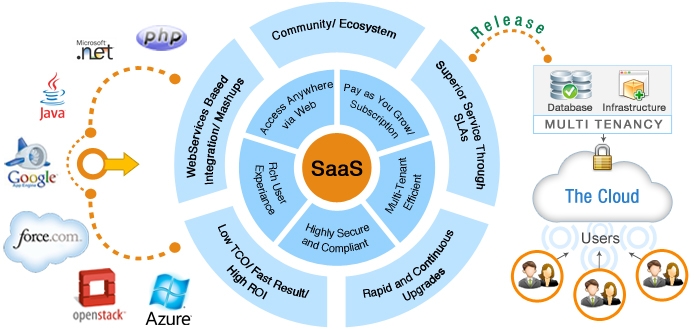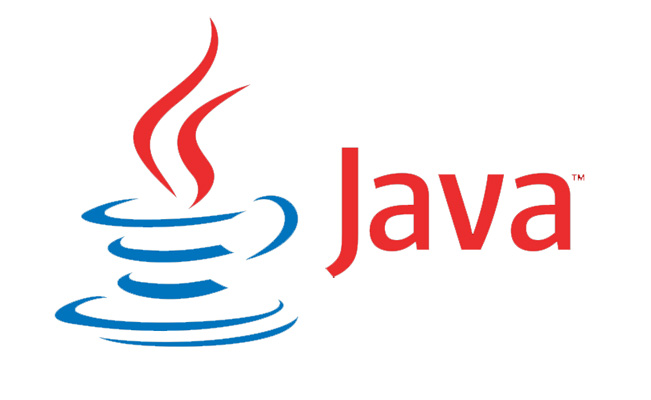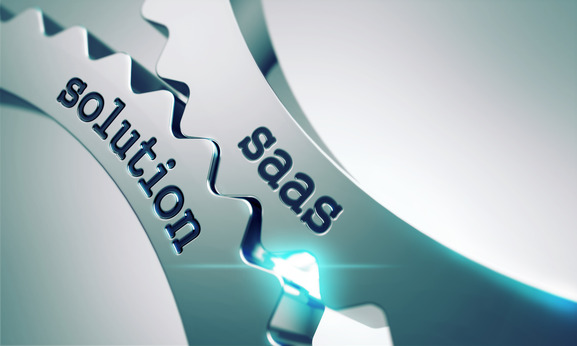Reasons for SaaS:
So you've decided your software product needs to be a SaaS application development Java. You've no doubt picked SaaS because your customers would like a cloud based application that they can access from the web anywhere they need it. This also implies your customer base has no interest in maintaining an IT staff to maintain software and equipment in-house. They are also interested in the low cost of ownership, on demand scalability, tailored Service Level Agreements, and the fact that "someone else" is worrying about upgrades, feature development, security, and all the other responsibilities that come from in-house development.

SaaS Strengths (courtesy of Rishabh Software)
Is Java the best choice?
You've probably decided on SaaS application development because the developers you've chosen to work with recommended Java. In the interests of comprehensiveness, there are several other choices, including:
PHP – very common and easy to work with, but less structured, which requires developers to be more disciplined—thus both quality and reliability can suffer. Facebook is built on PHP.
JavaScript – it's very cool that the browser client can be written in the same language as the application, but as there are fewer competent JS developers in the universe it can be more expensive. Walmart is built on JS.
Ruby – it's fast and favored by programmers, but it's subject to code dependencies on underlying software. Twitter is built on Ruby.
Python – is powerful and elegant but can be difficult to maintain. Pinterest is built on Python.
C# – an excellent choice for apps being developed in Microsoft environments. GoPro is built on C#.
Java – runs slightly slower and generally requires more memory, but is an excellent choice for a wide variety of platforms and is easily ported to Android should the need arise. LinkedIn is built on Java.
While the application or the environment may heavily favor one choice over the others, most applications can be built with any language. The most important thing is to have a strong development team that's facile and comfortable with the language chosen.
Al that said, Java is an all-around good choice because it requires more experienced and professional developers, facilitates solid structure and documentation, and development resources for it are readily available for maintenance down the road or augmenting the team should the need arise.
Considerations for SaaS application development Java
Architecture:
Solid consideration of the SaaS application architecture not only provides a blueprint for development but also forces upfront consideration of the important issues. There are many promised benefits to SaaS, but they can only be realized though careful consideration of the customer experience requirements and thoughtful examination of how a constantly running application can be updated, feature-enhanced, and scaled, while also providing performance, fault tolerance, and security. Future needs such as support for web browsers as well as mobile applications should be considered even if the initial deployment plans have a somewhat smaller scope. Properly architecting for these eventualities will make operation, maintenance, and expansion much simpler and cheaper down the road.
APIs:
Even if the initial deployment is for a single client with a highly prescribed interface, the core application should be accessed through APIs. The APIs should be very thoroughly thought out and properly architected and described to avoid future depreciation and maximize utility. This approach to architecture will ensure maximum return on investment of your SaaS application development java as you will discover ways to expand, maximize, and reuse your core software applications.

Optimal SaaS Architecture – (courtesy Cloudstrategies.biz)
Modularity:
A modular architecture allows for the design and implementation of independent bits of functionality with minimal but well-defined interfaces to other parts of the software. Proper consideration of a SaaS application development java modular design allows for efficient design and high reliability.
Services-oriented modules can be developed to interface to all the third party and system services that your application will be relying upon. As vendors, platforms, interfaces, or requirements change these modules can easily be updated or swapped without impact to, or even the awareness of, the end user.
Properly defined modules are loosely coupled with well-defined interfaces. This allows for the future enhancement or addition of features by simply adding new modules, or perhaps minimal updates to existing ones. This promotes much more highly reliable code while also maintaining application flexibility. Once again features can be added and updated without any down time with the proper additon or swapping of modules in a live system.
Modules should have a "stateless" design with respect to other components in the system. This is highly critical, allowing dynamic addition and subtraction of allocated resources to meet expanding and contracting demand needs on the fly. Each module should have sufficient information exchange handled by well-defined APIs so that its only dynamic memory needs are local. Otherwise very sophisticated memory management processes will need to be implemented, and reliability will be severely compromised.
Efficiency:
The whole idea behind SaaS is efficiency. The developer only has to build and maintain one application running in a cloud environment that they have to specify, maintain and control. The benefits to the end user is a very convenient "pay as you go" model that requires no in-house hardware or IT team. Licenses don't have to be maintained, equipment doesn't depreciate, and applications can be scaled up or down or switched without huge capital considerations.
Of course, to achieve maximum efficiency the initial architecture must properly consider and provide for many factors, including multi-tenancy, partitionability, and dynamic scalability.
In a multi-tenant environment several customers or instantiated users are able to operate behind the same firewall and utilize the same equipment and services as if each had their own dedicated resources. Robust APIs and session management are required such that rogue behavior on the part of any tenant, either unintentional or intentional, does not compromise or even affect the other tenants. Varying tenancy data models can provide for each tenant having their own data base, a common data schema, or in some cases (ie: static databases) actual shared databases. The application will dictate the model chosen for the tasks in question but care needs to be taken in considering reliablity, scalability and security.
For most users and software vendors, partitionable instantiations of instance specific sessions will be an important aspect of efficiency and overall maintenance, tracking, and reliabilty. Billing becomes more straightforward and understandable because it can be related to actual measureable system usage. At the very least system usage reports can be easily aligned with particular customer usage. Further development efforts can be effectively deployed to target resource-heavy parts of the application and thus reduce overhead. Faults can be more quickly identified, isolated, and rectified.
Assuming the architecture and implementation stayed true to good design and coding practices and produced a truly modular application, dynamic scalability should be possible. This is a boon to any SaaS provider, whether they are providing their own infrastructure or relying heavily on servicer providers. In the latter case the benefits are obvious – billing is most likely very closely correlated with usage and dynamic scalability will allow you to expand and contract your service needs as your client usage ebbs and flows. For those providing their own infrastructure, dynamic scalability allows for rapid expansion (or contraction) of your customer base by simply adding and subtracting additional resources as necessary. Servicing and maintenance should also be less disruptive to your customers as your dynamic session management capability should be able to allow you to take resources online and offline when necessary.
While SaaS application development java can lead to more resource-hungry applications, it can also be efficient in other ways. Java is more portable and less specific as regards to underlying hardware and OS requirements. It is easier to maintain a stable of "stand-by" Java developers to deal with problems since there are more of them in the labor market. The nature of the Java language and the skills required to develop Java applications also enforce more professional rigor and provide more structured code, allowing for greater flexibility in reliably allowing different developers to maintain the same code base.
Reliability:
All SaaS providers and customers place reliability at the top of their list of requirements for their applications. Customers want to ensure that their data and usage is secure, that the application is reliable, and that faults do not interrupt normal (and especially mission critical) usage. Providers want to be able to update and upgrade their offerings with minimal to non-existent customer interruptions, ensure that either unexpected exceptions or malicious use affect (worst case) a single session, and that all operations are secure to all parties.
Fault tolerance is an important consideration at all stages of architecture, design, implementation, and testing. Some developers go so far as to have test software that randomly corrupts data, code, API exchanges, or even deletes processes in order to test application robustness. Planning for such possibilities may seem extreme and even unfair, but it does lead to a reliable product.
System maintenance and upgrades are a necessary part of application maintenance and enhancement. The well built system will anticipate this necessity and provide procedures (as discussed above) to make this seamless and transparent to users.
Security is another "must have" for most customers. While cloud environments hosting SaaS application provide many security features on their own, application developers will find their most efficient products will not brute-force security by providing separate complete instantiations for each session, but rather treat security as an important consideration when designing and implementing modules. Efficiency and Security need not be naturally opposing design considerations with a thoughtful architecture.
Conclusion
SaaS application development java is popular for a reason. The language is well regarded, flexible, platform independent, widely supported, and many development resource options abound. SaaS architecture and development concerns around Modularity, Efficiency, and Reliability can be addressed in sophisticated and elegant ways. There are some drawbacks, namely performance issues and memory usage, but these shortcoming have been largely mitigated by ever improving JVM releases over the years and an ever-improving developer base and best practices. Some of the best and most widely used SaaS applications have been developed in Java by companies that have had every incentive and the resources to make the technology choices most appropriate for their needs. If you have decided on a Java SaaS application development you are in good company.
